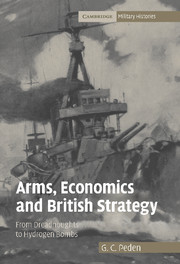Book contents
- Frontmatter
- Contents
- List of tables
- Acknowledgements
- List of abbreviations
- Introduction
- 1 The dreadnought era, 1904–1914
- 2 The First World War
- 3 Retrenchment and rearmament, 1919–1939
- 4 The Second World War
- 5 The impacts of the atomic bomb and the Cold War, 1945–1954
- 6 The hydrogen bomb, the economy and decolonisation, 1954–1969
- Conclusion
- Select bibliography
- Index
6 - The hydrogen bomb, the economy and decolonisation, 1954–1969
Published online by Cambridge University Press: 16 July 2009
- Frontmatter
- Contents
- List of tables
- Acknowledgements
- List of abbreviations
- Introduction
- 1 The dreadnought era, 1904–1914
- 2 The First World War
- 3 Retrenchment and rearmament, 1919–1939
- 4 The Second World War
- 5 The impacts of the atomic bomb and the Cold War, 1945–1954
- 6 The hydrogen bomb, the economy and decolonisation, 1954–1969
- Conclusion
- Select bibliography
- Index
Summary
Introduction
The period covered by this chapter begins with the Churchill government's decision in the summer of 1954 to produce a British hydrogen bomb, and ends with dependence on the American Polaris system to deliver it. The Americans exploded their first thermonuclear device on 1 November 1952, less than a month after the first British atomic bomb test, and between 1 March and 13 May 1954 they carried out a series of tests showing that they had mastered the techniques of making hydrogen bombs. A hydrogen bomb falling on a city could kill a million people, compared with the 50,000 fatalities to be expected from an atomic bomb. The Russians detonated a thermonuclear device in August 1953 and their first true hydrogen bomb in November 1955. The major consideration put forward by Churchill in Cabinet for developing a British hydrogen bomb was the effect it would have on Britain's influence in world affairs, and therefore on her ability to prevent precipitate action by the United States. The belief that Britain should have such influence was shared by the Leader of the Opposition. When the government's decision was belatedly announced in the annual Defence White Paper in 1955, in terms that left no doubt that Britain would use the deterrent rather than submit to Communism, Attlee remarked that, in his experience, possession of nuclear weapons did have an effect on the rulers of other countries.
- Type
- Chapter
- Information
- Arms, Economics and British StrategyFrom Dreadnoughts to Hydrogen Bombs, pp. 272 - 343Publisher: Cambridge University PressPrint publication year: 2007



